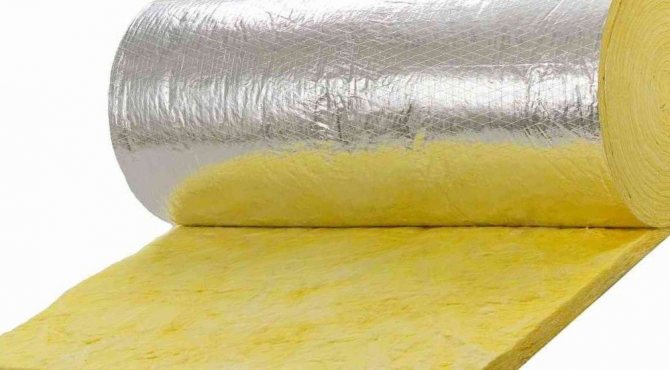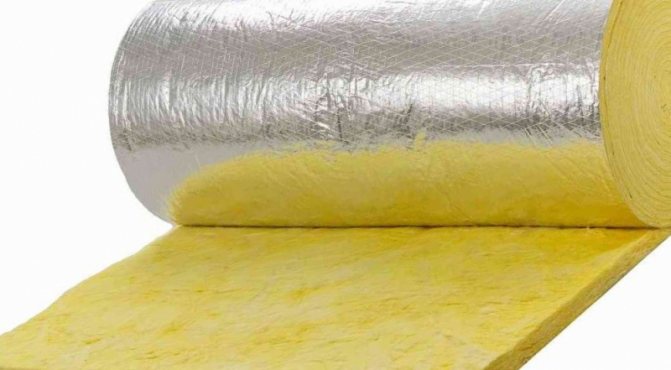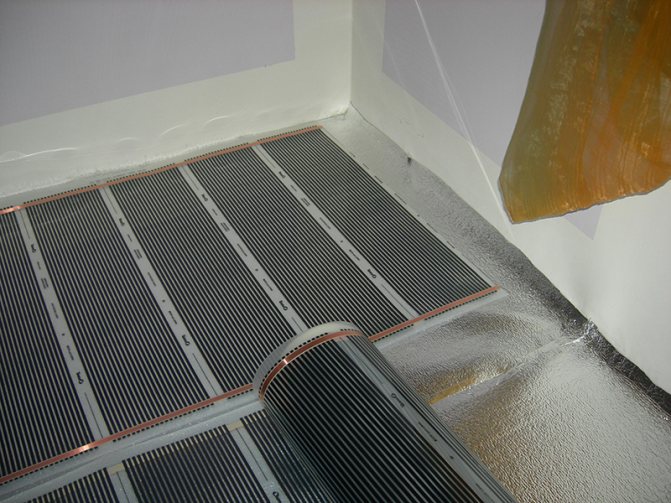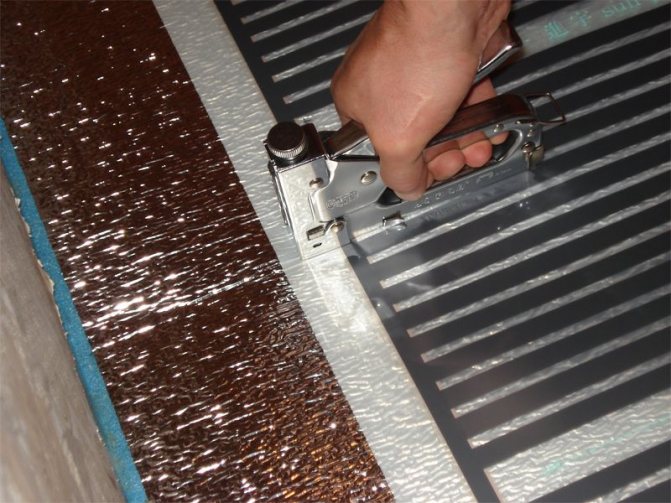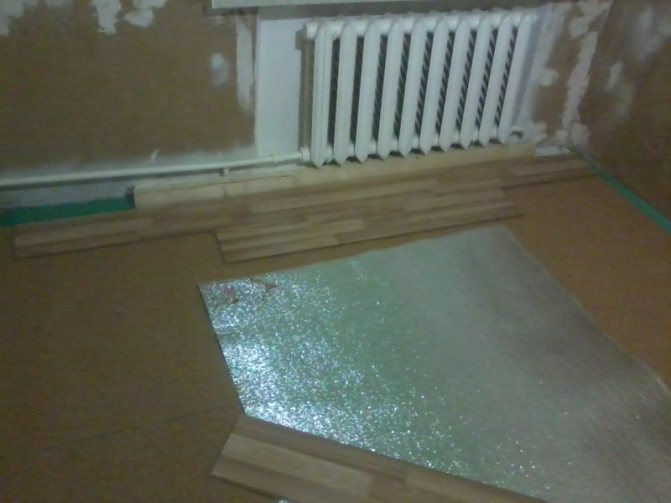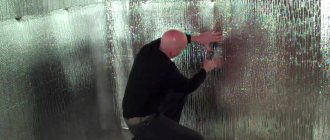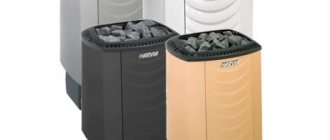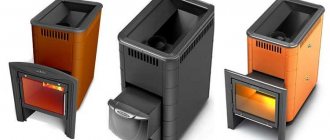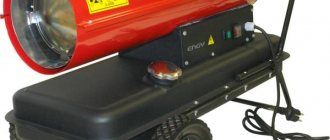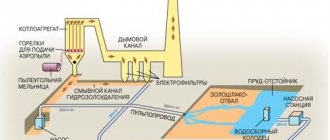Advantages of insulation with foil
Foil-type heaters have a lot of advantages that many other materials lack. It is for these positive properties that the foil thermal insulation is so loved by consumers:
- Effective reflection of thermal energy. Foil is an excellent reflector that repels about 90 percent of the heat, keeping the heat out and keeping the room cozy and warm. It is noteworthy that this property determines the fact that special suits for firefighters and rescue services are made on the basis of a foil-clad heat insulator.
- Waterproofing characteristics. Foil is a hydrophobic material that repels moisture.
- The convenience of use. Insulation material with foil has a cellular structure. Thanks to this, it is easy to install and perfectly insulates surfaces from moisture.
- Isolation of surfaces from external influences. The foil type of insulation does not let dampness, wind flows through itself, does not dry out in summer and does not freeze in winter.
- Noise suppression. The use of foil-clad insulation can reduce the amount of external noise in the room.
- Environmental friendliness and harmlessness. Foil has no negative effect on the human body. In addition, the material does not harm the environment and does not emit any toxins.
- Long service life. Foil is very durable, as it is not afraid of corrosion, decay and rust.
- High degree of elasticity. Foil material can be easily shaped into one shape or another.
Foil foam: which side to choose and is it really important to use it?
- 15 October 2020 12:15:03
- 3287
Most amateur tourists, every time they take tourist foam with foil on a hike, ask themselves the question: which side should they put - with the foil up or down? Let's solve this dilemma once and for all by also answering the question, do we need foil at all or not?
Empiricism and numbers
The thermal conductivity coefficients provided by the manufacturers for thick, thin or Izhevsk karemat, unfortunately, absolutely do not give us a complete idea of how much heat is retained at the moment when the tourist sleeps on it. The reason is simple - we know absolutely nothing about how warm the sleeping bag and thermal underwear used by a person have. It follows from this that you need to obtain information empirically.
For the experiment, you will need a digital thermometer, which needs to measure the top and bottom of the tourism rug in order to obtain data on the thermal conductivity of a sleeping bag, thermal underwear and a small layer of subcutaneous fat in a person as a whole.
Three tourist foams were selected as experimental specimens: thin 2 mm, standard Izhevsk 8 mm, and self-inflating camping mat 45 mm.
We will spread them on the concrete floor and let the volunteer lie down on the test mat in a sleeping bag and thermal underwear.
Data used:
- Concrete floor temperature (4-5 ° C)
- The temperature between the person and the rug (depends on the chosen foam)
- Internal body temperature (36.6 ° C)
At the moment when a person is on one of the rugs, the temperature is measured twice: under the foam, and also between the foam and the sleeping bag. This, recall, is done to determine the numbers that can give us an idea of the total thermal conductivity of human subcutaneous fat, thermal underwear and sleeping bag.
As a result, we managed to obtain very interesting data:
- A tourist mat 2 mm thick saves only from a drop of 8 ° C. It is very cold to sleep on such foam, it is practically impossible to get warm. According to preliminary calculations, the heat flux from a person is approximately 150 W / m2, of which 75 W goes into the ground. Considering the fact that a person emits 100 watts of thermal energy during sleep or rest, a result of 75 watts clearly indicates that a person will freeze;
- The self-inflating mat, 45 mm thick, gives a 26 ° C drop. Of course, sleeping on such a mat is much warmer and more pleasant. The heat flux from a person in this experiment is 40 W / m2, of which only 20 W goes into the ground, and this directly indicates that it is really warm to sleep on it;
- Izhevsk foam with a thickness of 8 mm gives an 18 ° C drop. Sleeping on it is definitely warmer and more comfortable than on a thin foam of 2 mm. The heat flux from a person in this case is 90 W / m2, of which about 40 W goes into the ground, which gives an obvious advantage, because Izhevsk rugs made of PPE with a thickness of already 10 or 12 mm provide a level of comfort that exceeds that of self-inflating cushions by 1, 5 times.
Foil efficiency: bottom or top?
As you know, in nature, heat is transferred in three ways:
- convection (movement of heated air by the wind outside);
- diffusion (the spread of one substance or state into another when they come into contact);
- radiation heat transfer or heat transfer (transfer of thermal energy to a colder body from a hotter one).
What does the use of foam with foil give in field conditions? It, of course, cannot help anything with either convective or diffusion heat transfer for the simple reason that the foil is effective only for radiation heat transfer, which can occur in a medium transparent to radiation. And, as you might guess, neither thermal underwear, nor a sleeping bag, nor, moreover, the earth, do not belong to them - they do not have radiation heat transfer. Consequently, there is nothing to remove the foil, from which its inefficiency follows.
Radiation heat transfer is possible only when there is an air gap between the sleeping bag and the tourism mat, which is a transparent medium, or there is such a layer between the human body and the ground. But, given that a person lies directly on the rug and there is no air space between them, we can conclude that foil does not work at all in terms of reducing heat transfer.
Why do you need foil on foam?
Let's anticipate your question and try to suggest that in this way the manufacturer wants to protect the travel mat from getting wet.
But, knowing the properties of modern materials used in the production of mats for hiking, which, in principle, do not get wet (for example, the well-known Izhevsk karemats, when immersed at a meter depth for 96 hours, absorb less than 1% of moisture), and this moment of the importance of foil can be safely question.
However, I still want to know exactly how foam with foil can help a tourist for its direct purpose - to eliminate radiation heat transfer and improve the thermal insulation properties from the ground? For example, under such a mat, you can put various dry grass, reeds or thin long branches - this will create sufficient air space, which undoubtedly will only play a plus, since air is an excellent heat insulator and heat is perfectly transferred through it by means of radiation heat transfer. In this case, the foil eliminates radiation heat exchange, providing a certain level of human comfort. If we appeal in numbers, then in the presence of a gap of 20 mm thick (all the same grass, branches, reeds) on the cushion of 2 mm, the thermal insulation is 17 ° C, which is 18% as a percentage of usefulness and this can be considered a good result.
Which side to put?
Despite the little inspiring data, we will try to answer this question. If there is no air gap, it is better to lay the camping mat with the foil down to protect it from moisture coming from below. If there is an air gap, it is recommended to lay it with the foil facing up.
However, in most cases, laying the karemat with foil down will be more correct, however, in normal hiking trips you do not need to rely on its magical heat-shielding properties - the tourist often sleeps in a tent where there are no air spaces, so the foil will not give any benefit. The only likely benefit of such a foam is moisture protection, as described above.
findings
This is not to say that foam with foil is a useless thing, but also not a panacea that can 100% protect you from cold and freezing.
Specifications and issue price
It is impossible to name the general characteristics of all foil-type heaters - different materials have different properties. But you can consider the characteristics of the most popular and affordable heaters.
Foil and polyethylene foam insulator
In most cases, the material is sold in compact rolls. The thickness of the insulation varies from 2 millimeters to 1 centimeter. Foamed polyethylene can be coated on both sides and on one side. In addition, self-adhesive material is found on the market, when one of its surfaces is covered with an adhesive layer and a protective film.
The scope of use of polyethylene foil insulation for walls, as a rule, is not limited: they are used to insulate floors and walls, roofs, ventilation, refrigerators or pipelines. Also, quite often, this type of heat insulator is used for installing a warm floor, for insulating baths and as a topcoat for linoleum or laminate.
To prevent the escape of heat through the wall structures, a layer of insulation based on polyethylene and foil is fixed behind the heating radiator so that there is about two centimeters of free space between the insulation and it.
Foil-clad polyethylene is often used in the manufacture of shoes - good shoe insoles are made of this material.
In building materials stores, there are often such names of materials as Ekofol, Izolon and Penofol. Price per roll is in direct proportion to the thickness of the material. For example, a roll of insulation with foil 2 millimeters thick will cost about 1,700 rubles. With a thickness of 1 centimeter, the cost will be about 3,500 rubles.
Mineral wool with foil
In this type of heat insulator, only one side is often trimmed with foil. It is sold in two different formats: rolls and slabs. The thickness of the insulating layer is from 4 to 10 centimeters. It is made on the basis of basalt wool or fiberglass.
The use of foil mineral wool is limited, since the material is harmful to human health, it causes lung disease and releases phenol into the environment. It is mainly used for external insulation of buildings and non-residential premises. Basalt wool is not subject to combustion, it is installed if resistance to high temperature indicators is required: on fireplaces, oven pipes, etc.
Properties such as moisture absorption, density and others depend on the brand and type of cotton wool, as well as the characteristics that were incorporated into the material by the manufacturer. The good waterproofing qualities of such a heater make it possible to use it in showers, saunas and baths.
The most popular brands Isover, Park, Ursa and Rockwool are considered. The cost of the material is approximately 1,300 rubles per 0.25 cubic meters.
Foil heat insulator made of expanded polystyrene
It is a thermoplastic with increased strength, which is obtained by melting polystyrene granules. It is produced only in the form of individual slabs. A similar material can be used in places that are subject to significant mechanical stress and moisture - strong polystyrene with foil is not subject to rotting and attack by mold or mildew. Therefore, it is often used when installing a warm water floor. The average cost is 90 rubles per stove.
The nuances of fastening and installation
Each type of insulation should be fixed on exactly the side that has the foil inside the building.
This allows the heat to be reflected inside the room. But disposable cotton wool or expanded polystyrene cannot be inside.
All insulation options should fit snugly to the supporting structures, but not shrink and be able to let air through. If foam is used, then its installation should be carried out with foaming of the joints of individual plates.
The type of insulation that is used in the form of a spray can be supplemented with a roll version of thermal insulation with a foil layer. But this kind of solution can only be applied to sections of walls and floors.
But as insulation of sections of the ceiling or roof, it is better to use a roll type of insulation or slab. It is easier to attach it to existing structures.
Such as neoprene, which can provide additional protection against generated noise. It is a topical solution for insulating roofs with metal tiles.
The resulting slab will reliably absorb noise from falling rain and wind. And the applied adhesive for fixing will create the required sealant between the individual joints of the roll material.
Also, on its basis, the procedure for additional insulation of the ceiling can be performed. Connecting to the surface of the subfloor or located lags, the insulation will create a single structure. This is in the case of a cold attic.
Features of the use of foil insulation
The use of materials with foil for insulation depends on a couple of indicators: the properties of a particular heat insulator and the place where it will be used. In general, with the help of such thermal insulation, floor structures are insulated, the heat transfer of heating radiators is increased, air ducts and pipelines are trimmed. An excellent result gives and thermal insulation of entrance doors to verandas, loggias, porches and balconies.
When installing foil-type insulation, you need to acquireall the necessary tools for work:
- Construction stapler.
- Small carnations with a large cap.
- Claw and hammer.
- Foil-coated construction tape.
- Insulation with foil directly.
The most common mistake of many builders is the incorrect installation of the material with the foil surface outward. Due to the fact that the foil is a reflector, it is designed to return heat to the room. And by placing the insulating material on the wrong side, such an effect cannot be achieved.
Stacking foil heat insulator, it is recommended to enclose it in a crate made of wood.
Boards, rolls or sheets of material must not be overlapped. They must be installed strictly on the same plane, secured with nails or construction staples.
The material that has an adhesive surface can be left without additional fasteners, but it is better to use small studs to increase the service life. In the absence of an adhesive coating, a rubber or acrylic adhesive can be used to fix the material to the surface.
After installation and fixing all layers heat insulator, the joints between them must be treated with foil tape.This completes the installation.
When installing the heat insulator on vertical surfaces on which there is mold, wallpaper or dirt, they must first be cleaned, otherwise the fixation will turn out to be very unreliable, and the material will simply fall off over time. In addition, it is recommended to treat the surface with antiseptic agents.
Easy-to-use and very high-quality foil insulation will save money and keep your home cozy and warm.
Foil material occupies a special place in a wide range of floor insulation materials. Thanks to the reflective surface, the effectiveness of the thermal insulation layer increases significantly, providing a comfortable environment in the home. Lightweight, durable, with good soundproofing properties, foil insulation for the floor is becoming more and more popular in private housing construction, especially since its installation is not particularly difficult.
Foil insulation for the floor
Which is better - foil foam or basalt insulation?

The building materials market is full of types of insulation. They have their own characteristics, positive, negative sides.
General parameters of thermal insulation:
- The weight. The insulation should not weigh much, because, when mounting it on the structure, there should be no weighting.
- Thickness. The thinner the material, the more space is left in the room.
- Low thermal conductivity.
- Moisture permeability. The material should absorb moisture as little as possible.
- Noise isolation. Does not pass sounds from the street.
- Environmentally friendly material. Should not emit harmful substances.
- Easy to install.
Comparing basalt insulation and foil foam, you need to compare their characteristics.
Basalt wool
Produced from rocks of volcanic origin. It does not burn, has good sound insulation performance, and does not lose its qualities over time. It is completely safe for health.
Composition and properties of foil material
This insulation consists of two layers - a base and a reflective coating. As a basis, classic heat insulators are used - foamed polyethylene, expanded polystyrene, mineral wool and other materials. The reflective coating is a metallized polypropylene film or a thin layer of aluminum foil. The thickness of the insulation directly depends on the type of base.
Foil insulation for the floor consists of two layers
Varieties of heaters
The insulation on polyethylene foam has a thickness of 2 to 10 mm and is produced in rolls. Usually it is used for the installation of a "warm floor", with further filling of the screed, and as an insulating substrate for some types of floor coverings. Self-adhesive material is especially popular, the installation of which takes a minimum of time. The insulation has many varieties, of which the most popular are Izolon, Ekofol, Folgoizol, Penofol and Isoflex.
Insulation based on fiberglass and mineral wool has a thickness of 50 to 100 mm, it is commercially available in the form of rolls and slabs. It is used for warming interfloor ceilings, thermal insulation of baths and saunas. Basalt insulation with a foil coating has increased heat resistance, but has one drawback: it contains phenol, which is unsafe for human health. The most popular brands of insulation: Knauf, Rockwool, Park, Izover.
Foil insulation Rockwool
A heat insulator based on expanded polystyrene is produced in the form of rigid plates covered with foil. It is used when laying a warm water floor, as well as for thermal insulation of surfaces exposed to dampness and heavy loads. For the convenience of laying heating pipes, special red markings are applied to the foil coating.
Insulation properties
Foil heat insulators have the following properties:
- high reflectivity;
- resistance to temperature extremes;
- moisture resistance;
- excellent steam, hydro, sound and heat insulation performance;
- resistance to mechanical stress;
- durability;
- light weight;
- ease of installation.
Floors with such insulation will never become damp, do not require treatment with protective agents, and will last much longer. Most foil-clad heat insulators do not contain carcinogenic components, therefore they can be used in any room, in addition, they reflect radiation, which is now important.
Aluminum foil reflects heat well
The type of coverage is of great importance. Aluminum foil perfectly reflects heat, but it breaks down under the influence of alkalis in concrete, and metallized film is not susceptible to such effects. That is why insulation with an aluminum layer is not used under a concrete or cement screed. The thickness of the reflective layer is no less important: some manufacturers make a simple spraying over the heat-insulating base, which significantly reduces the effectiveness of the insulation. The thinner the layer, the easier it is for thermal radiation to pass through it.
Where is the method of insulation with foil insulation applied?
Foil insulation reflects infrared rays, which are, in fact, thermal. But, you do not need to apply the material everywhere. In some places, it will not work as expected.
Basically, it is mounted at sources of thermal energy:
- heating devices - batteries, air heaters. The insulation is mounted on the wall with foil into the room;
- boiler, fireplace stove.
And also it is used when installing a "warm floor". The reflective layer will direct the heat in the desired direction.
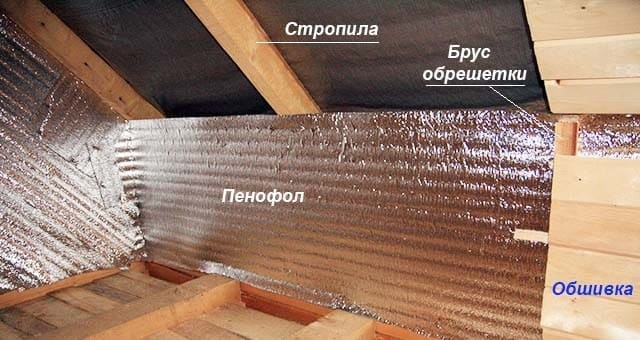

Small rooms, where every centimeter plays a role. Here, thin insulation will be appropriate on the walls and ceiling.
In the attic. Here the insulation is mounted on the roof. Apply 2 coats to combat heat and cold.
In baths and saunas. Heating of the room is not constant, foil material is suitable for such purposes.
Garages, hangars, outbuildings - an installed radiator or potbelly stove.
They also insulate heating pipes, air ducts, wells and wells.
Roll stacking technology
Roll stacking technology
Thermal insulation of a wooden floor
To work you will need:
- insulation;
- scissors;
- metallized scotch tape;
- roulette;
- grinder;
- antiseptic primer;
- putty.
Self-adhesive insulation is best for wood, but if you purchased a regular one, you can attach it to the surface using a construction stapler or double-sided tape.
We insulate the wooden floor
Step 1. Carefully prepare the base: remove the baseboards, remove debris and dust, treat the surface with a grinder or scraping. If there are gaps, you need to seal them up with putty.
Material characteristics
Each type must be laid using the appropriate technical solutions. And that is why there are requirements for the use of joining separate types of insulation with the presence of foil.
Foam polyethylene
The used roll material is excellently used for wall and floor decoration. Differs in high strength and lightness.
Also, its parameters will allow not to reduce the amount of living space and to fulfill all the assigned tasks for securing, without resorting to additional technical solutions, but using a simple construction stapler.
The resulting foam rubber acts as the basis for the inner side and the reflective surface of the material. It is also very convenient to lay it by dividing it into sections and corresponding floor areas.
Mineral basalt wool
This type of insulation should be laid in the same way as the previous one, placing the correct layer of foil and mineral wool.
The use of such insulation has a dangerous effect on the human body. Therefore, when working with him, respirators and special protective suits are used.
Recently, basalt wool has become very popular, which excludes this effect on the human body. At the same time, the material does not burn and is not subject to drying out.
Foam polystyrene
The material used is a kind of foam, which is located in the form of slabs, and its installation is carried out precisely not with the spreading of rolls, but with an accurate layout along the perimeter of the insulated section of the walls or floor.
For tightness, an additional self-adhesive foil tape is used. It ensures the tightness of the created system. The connection is made by one adhesive side.
Laying panel material
Reflective insulation in slabs
Reflective insulation in slabs is installed mainly under warm floors, although it can also be used as a conventional insulation. With foil mats, make a floating screed and put them between the logs.
Floating screed
Step 1. The concrete surface of the floor slabs is leveled with putty and sanding. Dust cleaning.
Step 2. Using a level gauge, mark the screed fill line on the walls.
Step 3. A damper tape is attached to the walls along the perimeter of the room and the base is primed.
Damper tapes Kermi
Step 4. Plates are taken with a metallized coating, since aluminum is corroded by cement. Glue is dotted on the base of the mats, after which the insulation is placed on the floor with a reflective layer up. When laying the insulation, the joints are carefully adjusted so that gaps do not form.
Step 5. The joints are glued with tape, and then the heat-insulating layer is poured with a screed solution. Level the mixture with a wide spatula or a rule and leave to dry. After that, you can lay the finishing coating.
Video - Laying foil mats
Warming on lags
Step 1. Remove the floor covering, clean the base from debris, check the integrity of the logs, repair damaged elements if necessary.
Step 2. A waterproofing material is laid on top of the logs and fixed with a stapler from the inside of the beams, well straightening the film on the floor. The edges of the canvases are overlapped by 10-15 cm.
Step 3. The space between the lags is filled with foil plates, laying them in one or two layers. The slabs of the second layer must necessarily overlap the seams of the lower layer. A gap of 1.5-2 cm is left between the reflective coating and the upper edge of the lag.If the gap cannot be left, a crate of 20x40 mm laths is stuffed on top of the lags.
Foil basalt mats
Step 4. Further steps depend on the type of flooring. If it is linoleum or laminate, the rough base is covered with sheet material - plywood, chipboard, OSB. If the floor is made of boards, they are stuffed directly onto the logs.
Table of the main properties of foil heat insulators
| Name | Properties | Thermal conductivity | Where is applied |
| Izolon | Elastic material, lightweight, waterproof and durable | 0.040 W / mK | As a substrate for laminate and linoleum, mounted under warm floors |
| Penofol | Flexible, thin material, environmentally friendly, waterproof | 0.037-0.049 W / mK | Can be used as a vapor barrier for conventional thermal insulation materials |
| Isover | Non-combustible, dense heat-insulating material | 0.041 W / mK | For insulation of concrete and wood surfaces |
| Rockwool | Durable, non-flammable material, resistant to deformation | 0.39 W / mK | Insulation of floors on logs, heat and sound insulation of walls and ceilings |
| Foil polystyrene foam | Resistant to temperature changes, durable | 0.037-0.041 W / mK | For insulation of a warm water floor, insulation of a floating screed |
Video - Foil insulation for the floor
Useful about blocks, mixes and concrete admixtures
Why do you need foil on foam?
Let's anticipate your question and try to suggest that in this way the manufacturer wants to protect the travel mat from getting wet. But, knowing the properties of modern materials used in the production of mats for hiking, which, in principle, do not get wet (for example, the well-known Izhevsk karemats, when immersed at a meter depth for 96 hours, absorb less than 1% of moisture), and this moment of the importance of foil can be safely question.
However, I still want to know exactly how foam with foil can help a tourist for its direct purpose - to eliminate radiation heat transfer and improve the thermal insulation properties from the ground? For example, under such a mat, you can put various dry grass, reeds or thin long branches - this will create sufficient air space, which undoubtedly will only play a plus, since air is an excellent heat insulator and heat is perfectly transferred through it by means of radiation heat transfer. In this case, the foil eliminates radiation heat exchange, providing a certain level of human comfort. If we appeal in numbers, then in the presence of a gap of 20 mm thick (all the same grass, branches, reeds) on the cushion of 2 mm, the thermal insulation is 17 ° C, which is 18% as a percentage of usefulness and this can be considered a good result.
How To Lay Foil Insulation On The Floor
- Anara Posted on 01.02.2019FollowNo Comments
There are a huge number of different heat insulators. Foil insulating material reflects up to 97% of infrared radiation towards its arrival.
It is made based on expanded polystyrene, foamed cellophane, mineral and basalt wool. Its efficiency depends on the correct installation.
Next, let's see which side to put the heat insulator with foil on the floor, the types and properties of materials, the rules for laying them.
This is a combined material that consists of a layer of duralumin foil or a metallized film, combined with a heat-insulating material. You will like the reflective layer more one-sided as it is also called two-sided. Differs in easy and quick installation due to its own elasticity. Narrower than other thermal insulation materials.
The aluminum coating has the greatest characteristics in terms of heat reflection, alas, it is destroyed by the action of alkalis in concrete. The metallized coating is resistant to alkaline attack. Spraying doesn't actually do a function of its own.
In addition to retaining heat, it is used for waterproofing, because it does not allow water to pass through itself. The thinner the foil layer, the better it allows heat to pass through itself.
There is a huge variety of foil-clad heat insulators.
They differ in the materials used at the production stage.
The properties of heat insulators with a foil layer are described in the table:
When choosing, it is necessary to take into account the requirements for the premises and its functional purpose. The top layer is expected to be covered with duralumin foil, and not by spraying.
Foil insulation construction
Thermal insulation with foil is produced in:
They differ in size, thickness and the base layer used, covered with foil.


Base layer types:
- polyethylene foam;
- basalt wool;
- expanded polystyrene.
The foil is glued to the base layer or applied by spraying.
Some have layers of foil on both sides. Or with a layer of applied adhesive - self-adhesive, which allows for easy installation. Self-adhesive is used in corners, on uneven surfaces. Insulation joints are glued with foil tape.
When buying a heater with a reflector, you need to pay attention to:
- base layer;
- foil thickness;
- taped with reflector on one side or both.
Depending on the base material used, the thickness of the insulation itself is.
How do I lay the underlayment on the floor?
When the material is laid, of course the selected floor covering must be installed.
The base for underfloor heating must be level without height differences and flaws. What remains for our client to do is to remove errors.
Stages of laying thermal insulation with a layer of foil:
- Lay out the foil material in strips end-to-end, glue the joints with special tape.
- From above we mount a system of electronic or water heated floors.
- We lay hydro and vapor barrier material. It will prevent the concrete from leaking onto the floor heating elements.
- We fill the screed with a width of 30-50 mm, starting from the type of heating parts and the multifunctional purpose of the room.
Warm floors have an option to turn on only after the screed is completely dry. It will take about a month.
It is characterized by the fact that the slab does not bond aggressively with the concrete screed, they have thermal insulation.
- We prepare the base, we eliminate our client's shortcomings.
- We plaster the lower part of the walls.
- We glue a damper tape around the perimeter of the walls, its height must be the thickness of the floor: from the slab to the floor covering.
- We prime the base in two layers. Apply the next layer after the previous one has dried.
- We lay the heat-insulating foil plates upward with foil. We use a metallized coating that is resistant to cement mortar. Plates are laid strictly in a horizontal plane, tightly together. Uneven laying of insulation boards promotes the formation of cracks in the concrete solution.
- We glue the joints of the plates with adhesive tape.
- Fill the screed with concrete.
Lightweight and durable heat insulator with a layer of foil is used by our client and remains more popular among consumers and professional builders due to its high heat retention characteristics and ease of installation. For more on isolation, see the video here:
Subtleties of the connection of the insulation with the foil base
It is important to properly glue and join both rolled and slab insulation. After all, ordinary building plaster and glue are unusable.
A special version of foil tape will be required, with an adhesive base. Then the thermal insulation and the entire installation performed will be performed correctly.
Such solutions are very relevant for a modern frame house, or they are applicable in a wooden house. The combination of special criteria for layering with the possibility of overlapping cold bridges makes the use of insulation more practical.
Watch the video in which the specialist clearly explains how to properly strengthen the foil insulation behind the battery:
Varieties of material
Let's look at what the types of insulation are called:
- With foamed polyethylene, it looks like a roll of self-adhesive material, similar to a film with foil. The scope of application in various equipment, sheathing of pipes, shafts, roofs, since it has a high temperature range from -160 to +160 degrees, is fire resistant.
- Mineral wool with a foil coating, can be in the form of a plate, a cylinder. Also has a high degree of fire resistance.
- Expanded polystyrene, treated with foil on both sides. Also has a wide temperature range, the diameter can be 5mm, 10mm, 15mm.

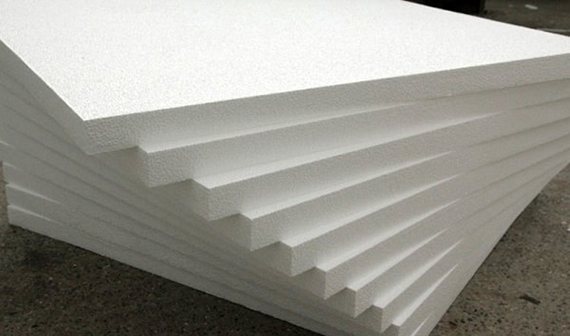
- Basalt, just like the above materials, is made on the basis of foil-clad material, however, thanks to a unique technology, it can withstand temperature fluctuations from -200 +600 degrees, and is resistant to aggressive chemical environments.
How to put insulation on pipes
As a rule, such a material has the form of a pipe "cocoon" made of mineral wool (withstand high temperatures) or expanded polystyrene (moisture resistant). And how to insulate them, the question disappears in itself, since they have the form of a "cocoon", which is put on top and fixed. There are main lines for chimneys of various diameters and temperature regimes.
However, if you decide to purchase a sheet of insulation, you may be faced with the question of how to glue it to the metal? Aluminum tape will come to your aid, which is wound on the insulation over the pipe. And, as in the above options, you must dress with the shiny side to yourself.
Is it possible to insulate the walls from the outside
To insulate the walls from the outside, perforated foil insulation is used. This material, which, among other things, has soundproofing qualities, is able to protect your home from moisture and wind, and also does not prevent moisture from leaving the room. This option is ideal for those who do not have the opportunity to do this kind of work indoors. However, such activities can only be performed during the warm season and in dry weather.
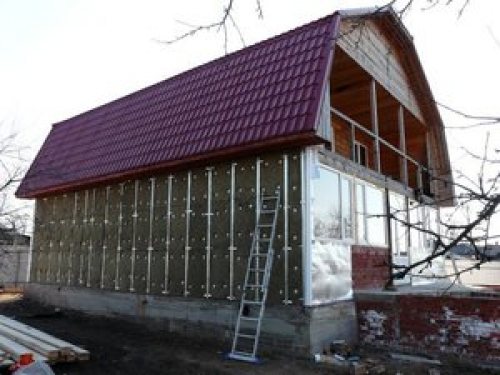

To do this, you will have to do the following:
- If you had any covering on your wall, you need to get rid of it. Then treat the surface with an antiseptic solution. It is better to do this in hot weather, so that everything dries out well, especially carefully treat the lower part of the building. The surface will dry completely within two days.
- Next, build a frame from a bar, fix it with self-tapping screws. Lay Penafol, then leave the air tunnel, glue the joints, then mount the outer frame.
In conclusion, we suggest watching a video about the installation of Penofol thermal insulation:
Installation of foil insulation


Foil insulation has a fairly wide range of applications, it is used for insulating pipes with cold and hot water, for insulating walls, as a substrate when laying parquet or under a laminate, for insulating hives, soundproofing a room, roofing, insulating ventilation ducts, insulating industrial equipment.
This insulation is used to sheathe the walls from the inside of the room behind the batteries to reduce heat loss, since it is heat-resistant. The following brands are represented on our market: Alufom, Ursa, Penofol, Folgoizol, Izolon, Knauf, Lavsan, Magnel, Megaflex, Penoplex, Ecoteplin, the most popular type is with foil and foamed foam.
How much does this material cost? It all depends on the manufacturer you prefer, the price ranges from $ 1 to $ 4 per meter2. Let's try to take a closer look at how to properly lay this material on various surfaces.
Often, the walls are insulated with a similar material in baths, saunas, on balconies, in this case, a material based on a polyethylene base is used. It is recommended to use insulation with a thickness of at least 10 mm, such material can be covered with foil both on one side and double-sided.
If we consider the options for what it can be attached to, a construction stapler, double-sided tape is best suited, you can also use a special rubber-based glue, the joints of the sheet are glued with tape. If we are talking about the insulation of the balcony, then you need to lay an additional heat-insulating layer, for example, foam, basalt material or others.
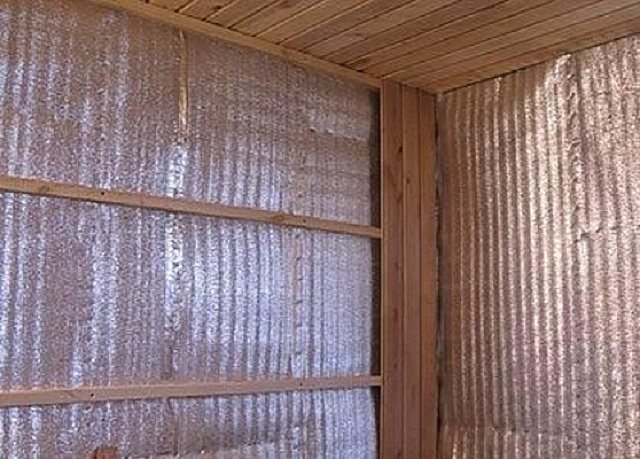

Is it possible to insulate without them? Of course, yes, but you will not get the desired result. In order for the insulation to fulfill the task assigned to it, it is necessary to figure out how to properly lay it. The distance between the material and the skin should be approximately 20 mm, this will create a kind of air gap that will serve as an air barrier.
Let's consider in detail how to properly attach to the wall:
- Attach the styrofoam to the previously prepared surface.
- Fix the foil insulation on top of it.
- Then install the wooden blocks on top, then sew up everything with the selected material (gypsum, siding), sew up the joints with foil tape.
To the ceiling
As a rule, the maximum thickness of the insulation is chosen for the ceiling, since all the heat rises up, and its maximum losses occur there.Due to its reflective surface, the insulation is able to reflect up to 90% of heat, thus increasing the overall efficiency of the insulation system by 60%. These characteristics will be obtained subject to the installation rules.
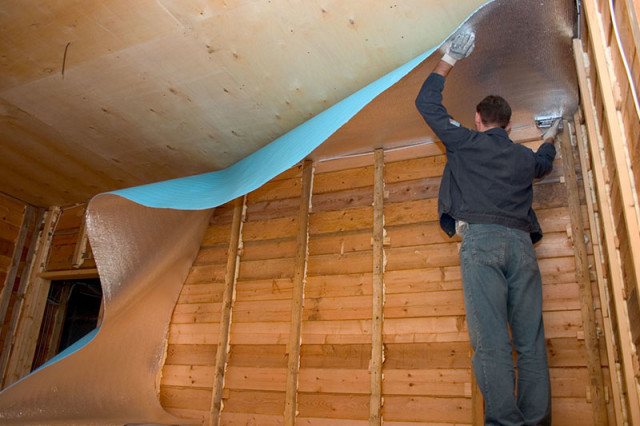

To carry out the work you need the following:
- Construction stapler.
- Small nails.
- A hammer.
- Insulation material.
- Aluminum tape.
Such a product is sold in rolls; for ease of installation, cut it into the required lengths. And which side to lay it on? Installation must be done so that the foil surface is inside the room (with the silver side facing you). So, let's figure out how to nail this material.
The gap between the finishing material and the insulation should be about 20 mm, this buffer zone protects the room from heat loss.
When fixing to the ceiling, fix it using a stapler, the fixing should be joint to joint, and glue the mounting seams with aluminum tape to ensure hydro and thermal insulation.
Perhaps the installation process on the floor is the most laborious, and there are more possible variations, since you can lay under linoleum, parquet, laminate, underfloor heating system (not only water floor). All this is possible thanks to its non-combustible basis, since there is a reflective foil on one side, and foam rubber on the other.


Some manufacturers have variations where there is foam rubber on both sides. So, we will describe in more detail the process of installing a wooden floor. To do this, we need the following: a construction knife, insulation, aluminum tape, meter, grinder, antiseptic primer, putty.
For this type of work, it is better to give preference to material with an adhesive base, however, you can get out of the situation with double-sided tape.
Work order:
- Prepare the base, remove the skirting board, grind the floor, if there are any irregularities, remove them using a putty.
- Treat with an antiseptic liquid. After drying, take measurements and cut into desired pieces. Lay a sheet, there should be foam rubber inside, and foil outside.
- Seal the seams using metallized tape.
- Then lay parquet, laminate.


If you are insulating a concrete floor, the technology is similar, however, it is better to use specialized rubber glue for gluing. Otherwise, the technology is the same. If you have a very cold floor, in such a case, wooden logs are stuffed onto the insulation, the niches in them are filled with insulation material, sewn on top with sheets of OSB plates, then the selected coating material is primed and laid.
Laying methods
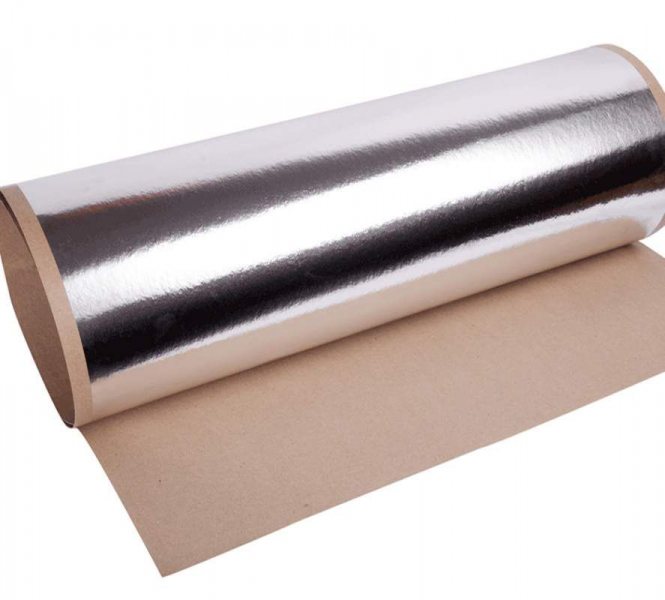

Consider which side to correctly lay the insulation with foil on the floor.
Heat-saving properties depend on how well the insulation is laid.
The foil reflects infrared radiation, therefore, the metallized layer must be laid so that it looks into the room.
Insulation of a concrete floor


Place the packing material with the foil facing down.
Most often, the roll material is fixed to a concrete base on a special glue made on the basis of rubber.
- Preparing the surface. We align the slab so that there is no large difference in height. We seal all cracks and cracks with cement mortar.
- We spread the material on the floor with a foil layer upwards, cut it to the required length. We move the strip, apply glue to the place of its laying. We stand for several minutes according to the instructions for the glue. We lay and press the material well. We put the strips close to each other.
- We fix the joints with foil tape, which is sold in hardware stores.
For additional insulation of cold floors, wooden logs can be laid on top, the space between which is filled with slab insulation. On top of it, floorboards or sheet material (OSB, fiberboard, chipboard) are placed.For an interesting comparison of foil materials, see this video:
You can fix the material on double-sided tape, glued around the perimeter, or dowels.
Thermal insulation of wood floors
The most convenient way to lay the material on the adhesive layer
It is most convenient to lay foil insulation on a wooden floor, which has a lower self-adhesive layer.
If you bought material without an adhesive base, then you need to fix it on staples using a construction stapler or on double-sided tape.
- We remove the skirting boards, remove debris and dust with a vacuum cleaner.
- If there are irregularities on the boards, we grind them with a special machine, if necessary, we perform scraping (remove the top layer of the board).
- All existing cracks are sealed with wood putty.
- We prime it with an antiseptic composition.
- We measure the room, cut out the roll, put it upside down with foil. It can be easily cut to size with sharp sewing scissors.
- We lay out in strips end-to-end. We wait a day for the material to settle down and straighten out. If the heat insulator has a self-adhesive base, gradually remove the protective film and press it tightly to the surface. Lay the next strip end-to-end.
- The joints of the strips are fixed with foil tape.
Once the material has been installed, the selected floor covering can be installed.
Foil insulator for underfloor heating
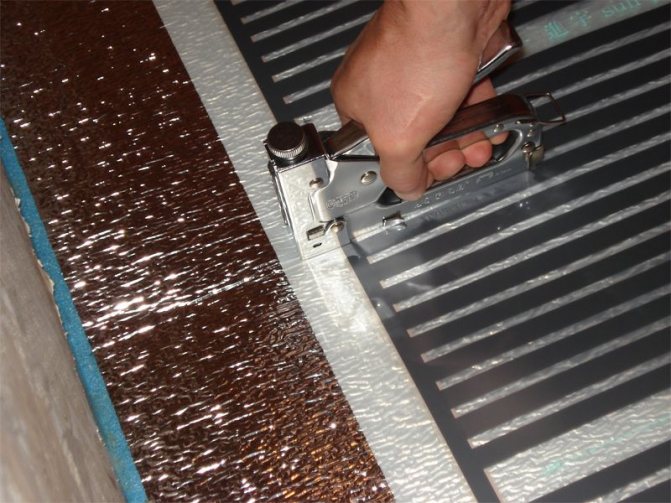

When installing the insulator under underfloor heating, lay the material with the foil facing up so that it reflects heat into the room.
The base for underfloor heating must be flat without height differences and defects. All errors must be eliminated.
Stages of laying thermal insulation with a layer of foil:
- We lay out the foil material in strips end-to-end, glue the joints with special tape.
- On top we mount a system of electric or water heated floors.
- We lay hydro and vapor barrier material. It will prevent the concrete from leaking onto the floor heating elements.
- We fill a screed with a thickness of 30-50 mm, depending on the type of heating elements and the functional purpose of the room.
Warm floors can be turned on only after the screed is completely dry. It will take about a month.
Floating screed insulation
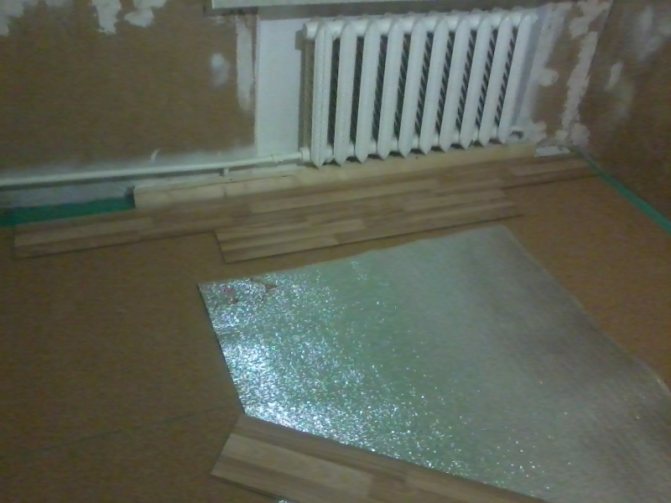

Having bought a two-layer material, you can not bother with the question of which side to lay the insulation
It is characterized by the fact that the slab is not rigidly fastened to the concrete screed; thermal insulation is placed between them.
- We prepare the base, eliminate all defects.
- We plaster the lower part of the walls.
- We glue a damper tape around the perimeter of the walls, its height should be along the thickness of the floor: from the slab to the floor covering.
- We prime the base in two layers. Apply the next layer after the previous one has dried.
- Lay the heat-insulating foil plates with the foil facing up. We use a metallized coating that is resistant to cement mortar. Plates are laid strictly in a horizontal plane, tightly to each other. Uneven laying of insulation boards promotes the formation of cracks in the concrete solution.
- We glue the joints of the plates with adhesive tape.
- We fill in the concrete screed.
